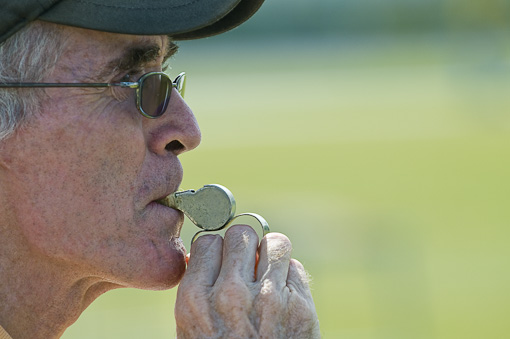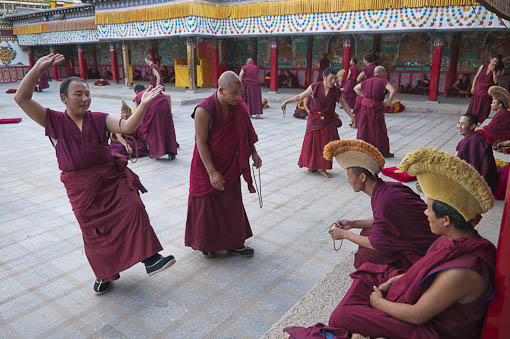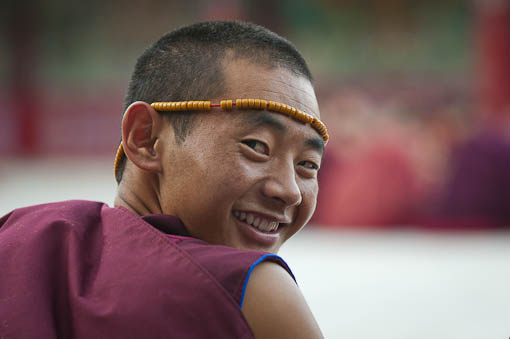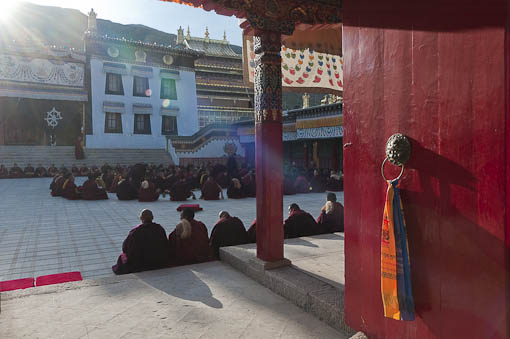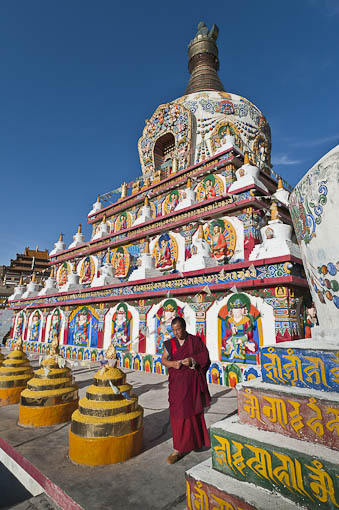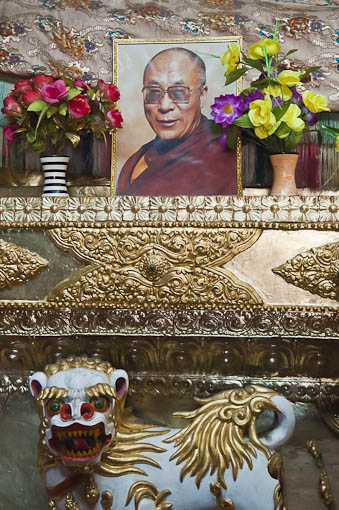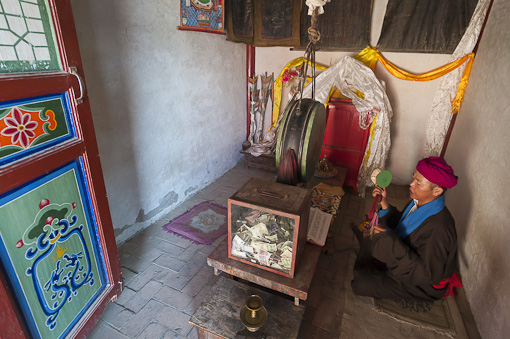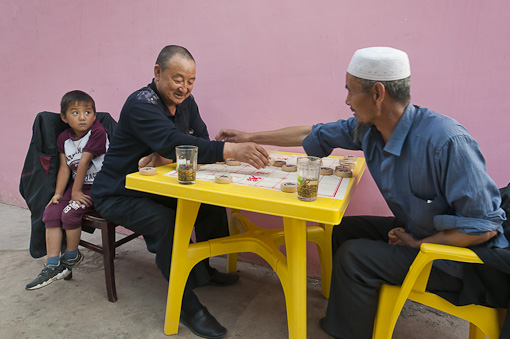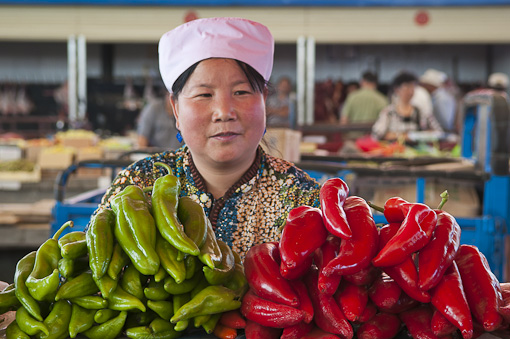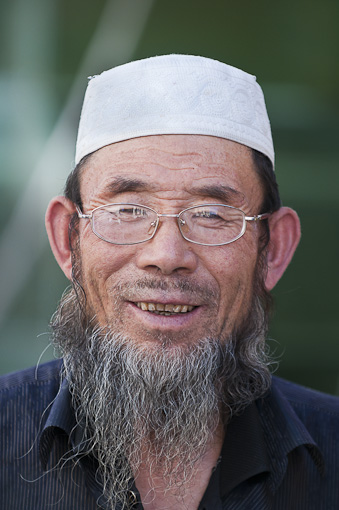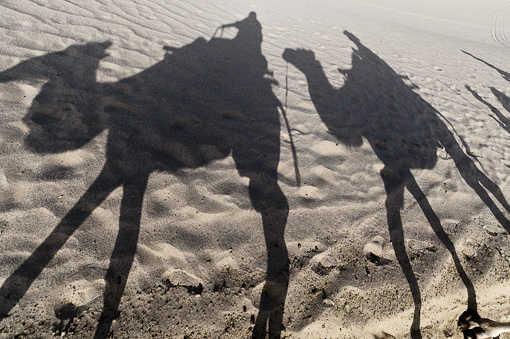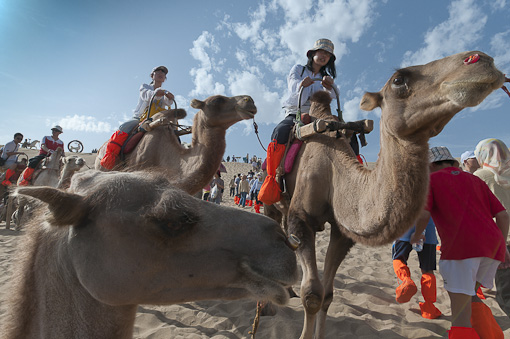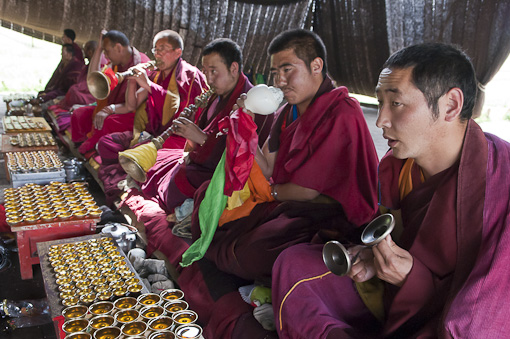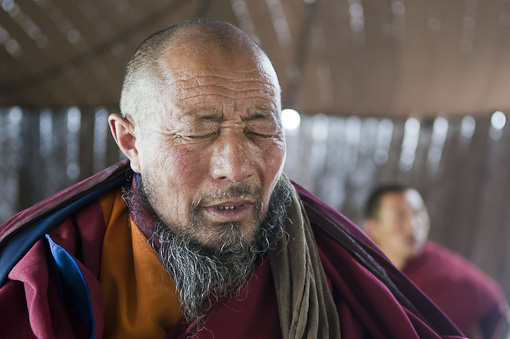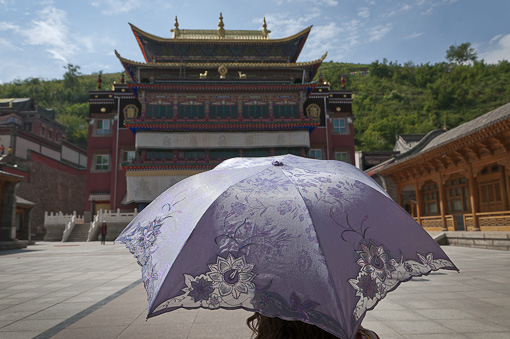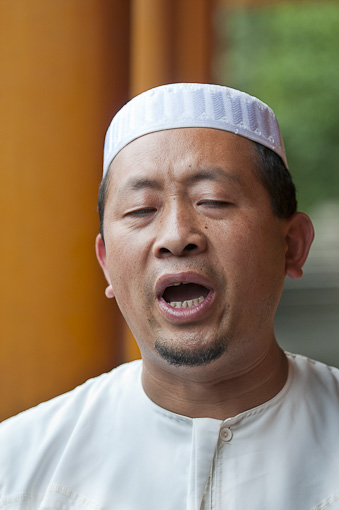Sometimes making sense out of a complex soundscape is like photographing a chaotic scene ... at first, you just can’t see the forest through the trees.
Which are my key sounds ? Can I isolate them from the background noise ? Is that sound reconcilable? How will it help tell my story ? Will the viewer experience the real life scene in front of me ?
In the above audio slide show listen for horns, conch shells, and cymbals fading to chanting, then scooped rice and finally clanging tea cups. I Pad friendly version.
Upon entering the Arou Ba Temple in China’s Qinghai Province, my senses were blasted by the monks blowing low notes on eight-foot-long brass horns. Squawking reed instruments competed with ringing finger cymbals. The Yellow Hat sect Tibetan Buddhist monks were chanting, slowly at times, then as rat-a-tat-tat fast as an auctioneer.
At first I listened and watched to get a handle on the action, and for the monks to become accustomed to my presence. I began to use my recorder’s shotgun microphone to select one sound at a time, choosing my story building blocks carefully. If one monk’s chanting was distinctive, I recorded it. When all the instruments played at once, I sensed the complex acoustic mix would be my intro. Three voices were playing off each other, so I placed my omnidirectional mic to capture the layers of sound.
I especially enjoyed discovering the sound of rice being scooped up and dropped over a series
of decorated silver bowls and rings, a meditation performed together by two monks.
As I saw a compelling image, I’d break for photography. One by one my story elements, once hidden between the trees, showed themselves to me and were recorded or photographed. An incredibly fascinating forest emerged.
Here's a link to past posts from my three week trip to China last July.
Wednesday, December 15, 2010
Sunday, December 5, 2010
Sounds Overheard: Quacking Toy Ducks & The Law
Keeping an eye out for the law, grown men are playing with whistling toys on the Saturday morning I visit the San Telmo street market in Buenos Aires.
Hear the bustling San Telmo street market in this one minute sound clip.
Quack quack quack, buy “the little duck !” one man offers. Amid a long shrill and trill, an entrepreneur announces “canaries, for children, help your self !” At first the third is wary of my microphone, explaining they are unlicensed street vendors and keep a look out for the police. “Portuguese roosters!” he shouts as he scurries down a cobble stone side street.
The weekly market overflows from Plaza Dorrego, the Argentine capital’s oldest, along streets lined with colonial era architecture. Street musicians and tango dancers perform, tourists and locals fill the outdoor cafes, and antique shops hide treasurers.
During my assignments and travels I've been recording the sounds I overhear, and many don't have supporting photographs or stories. This occasional series will be my excuse to share my audio orphans, these Sounds Overheard.
Monday, November 29, 2010
Never Say Never - Insightful Voices Drive Multimedia
Roger’s favorite high school subject is English, taught by his favorite teacher Brother John Corcoran, who is also his cross country coach. Such relationships provide many teaching moments. But Roger’s greatest inspiration has been observing his mentor quietly overcoming adversity.
Link to iPad and iPhone friendly version.
During our taped interview earlier this year discussing why he liked attending Archbishop Curley Notre Dame, Roger described Brother Cocoran as an interesting and approachable teacher, as well as a challenging and goal-setting coach.
Over the past school year Roger and his teammates have watched their coach recover from an accident, return to walking and then to full duties at school. Roger has learned “to never say never,” an unofficial lesson.
Such insights, straight from the student mouths, have been the driving force behind the six-part multimedia series ACND commissioned to focus their “There’s A School For That” campaign. By using journalistic still photography and public-radio-style audio interviews, the small Catholic prep school on the edge of Miami’s Little Haiti neighborhood is growing enrollment and strengthening ties with its support community.
Anecdotal reports suggest these audio slide shows are succeeding in small ways:
- A mother reported her son insisted on enrolling at ACND after being impressed by their web site, where the shows are featured
- Another new student said he chose Curley “to find my athletic potential," directly borrowing a line from one show.
This is my sixth and last post about this project. Thanks again for the help of Principal Brother Patrick Sean Moffett, CFC, his assistant Daphne Dominique, Dean of Students Douglas Romanik, and former Public Relations director Catherine Doble.
Here are all six multimedia audio slide shows from Miami high school Archbishop Curley Notre Dame.
Monday, November 15, 2010
Sounds Overheard: NYC Subway
The $ 2.25 to ride the New York City subway is probably the best entertainment admission price in town, especially if you travel through the underground with your ears wide open.
Earlier this month I recorded the sounds of a classical Spanish guitarist, then a Manhattan bound train arriving, doors closing, being whisked to another station, where I’m finally left alone on an abandoned platform. Direct link to two minute clip here.
Sure you need your eyes to read the stories on your fellow traveler’s faces, spot the rat running down the rails, be amused by the zombie Halloween costumes. But listening to the sounds surrounding you will make the trip much richer.
Conversations in Polish, Spanish, Chinese and where in the world are they from ? Music from violins, flutes, drummed upon plastic buckets. Humming air conditioning, whooshing air brakes, ear shattering screeching. Foot steps, the train fading down the tunnel, now it’s quiet.
During my assignments and travels I've been recording the sounds I overhear, and many don't have supporting photographs or stories. This occasional series will be my excuse to share my audio orphans, these Sounds Overheard.
Sunday, October 31, 2010
Close Encounters Of The Alligator Kind
I received a stock photo request this week from National Wildlife magazine expressing an interest in using an alligator photograph of mine to illustrate an article about their favorite places to see wildlife.
While I was digging the image out of my digital archive I got to thinking about the fun times I’ve had with Alligator mississippiensis.
Alligator finds dwindling pond at height of dry season, Everglades NP
Don’t worry, I’m not a mountain man with wild beasts stories, or a species discovering biologist nor an accomplished wildlife photographer. I’m just a guy looking to enjoy the outdoors, and photography and kayaking are great excuses to do so. In Florida, alligators come with the territory.
Nine Mile Pond is my favorite place to paddle in Everglades National Park as it features a five mile loop threading between mangrove islands and over the sawgrass prairie, all with water not much deeper than a paddle blade. Fluffy clouds and blue sky mirror themselves on the water. Wading birds and fish eating Osprey fly above. If you are going to experience just one Everglades paddle, this is it.
Rising sun warms alligator's back, Everglades NP
But by the middle of May two years ago it was the heart of the dry season, and I paddled off the pond and down a mangrove covered trail. The water was as wide as my paddle, about 18 inches deep, and muddy brown. After a hundred yards, I could see about a dozen ‘gators up ahead enjoying the only other body of water left, a house sized pool.
Female gator gently touches male to say she's ready for love, Everglades NP
I stopped paddling and drifted forward, and suddenly felt a solid bump transmitted through the kayak’s hull and directly to my back side an inch above. I listened to a scraping sound run down the length of my boat and imagined rocks protruding from the murky bottom. As my stern cleared, I looked over my shoulder only to see a six foot long alligator rise up to the surface. I had run over a gator, and was drifting toward a dozen more.
American Alligator makes daily stroll from Flamingo Bay to Eco Pond, Everglades NP
Now if you are an experienced swamper please tell me if I’m wrong, but I’ve always reasoned that my 12-foot-long orange craft looks like a big old predator in an alligator’s eye. Why would they attack me? No worries, I thought, I might as well make a few photos, and that’s when I shot the seven footer in the top photo as it drifted by my wide angle lens .
While I was digging the image out of my digital archive I got to thinking about the fun times I’ve had with Alligator mississippiensis.
Alligator finds dwindling pond at height of dry season, Everglades NP
Don’t worry, I’m not a mountain man with wild beasts stories, or a species discovering biologist nor an accomplished wildlife photographer. I’m just a guy looking to enjoy the outdoors, and photography and kayaking are great excuses to do so. In Florida, alligators come with the territory.
Nine Mile Pond is my favorite place to paddle in Everglades National Park as it features a five mile loop threading between mangrove islands and over the sawgrass prairie, all with water not much deeper than a paddle blade. Fluffy clouds and blue sky mirror themselves on the water. Wading birds and fish eating Osprey fly above. If you are going to experience just one Everglades paddle, this is it.
Rising sun warms alligator's back, Everglades NP
But by the middle of May two years ago it was the heart of the dry season, and I paddled off the pond and down a mangrove covered trail. The water was as wide as my paddle, about 18 inches deep, and muddy brown. After a hundred yards, I could see about a dozen ‘gators up ahead enjoying the only other body of water left, a house sized pool.
Female gator gently touches male to say she's ready for love, Everglades NP
I stopped paddling and drifted forward, and suddenly felt a solid bump transmitted through the kayak’s hull and directly to my back side an inch above. I listened to a scraping sound run down the length of my boat and imagined rocks protruding from the murky bottom. As my stern cleared, I looked over my shoulder only to see a six foot long alligator rise up to the surface. I had run over a gator, and was drifting toward a dozen more.
Now if you are an experienced swamper please tell me if I’m wrong, but I’ve always reasoned that my 12-foot-long orange craft looks like a big old predator in an alligator’s eye. Why would they attack me? No worries, I thought, I might as well make a few photos, and that’s when I shot the seven footer in the top photo as it drifted by my wide angle lens .
Wednesday, October 20, 2010
Faces On The Radio
As my ears thumped to the pounding rhythm of goat skin drums, my eyes were arrested by the heavy coral beads hanging from the young Tibetan girl’s hair. I heard tinkling silver bells. I saw orange color. I heard the crowd, then saw her intense expression. Sound and sight sent my brain the story of hundreds of folk dancers and musicians driving the devil from a Buddhist temple.
Click here for an iPad friendly version of the audio slide show above.
While traveling in China’s remote north western province of Qinghai this July, I found that my ears had become just as sensitive as my eyes. I would discover an interesting natural sound, bleating sheep, whooping celebrants, chanting monks, and then I’d find a portrait to photograph, putting a face on that sound.
When working in multimedia I like to close my eyes and imagine the sound coming from my car radio, and ask, “do I see what I’m hearing” ? Yes, then lets put a face to the sound. Lets put a face on the radio.
Photography and natural sound work together beautifully to produce a richer, fuller story than either component could on their own. In this two minute audio slide show I chose 13 portraits of Chinese I met - Han, Tibetan and Hui - and wrapped a field-recorded sound clip around the photograph.
Close your eyes and listen ... what can you see? Now open your eyes to hear even more.
I wrote almost every day about my July experiences here. More multimedia photography from China can be viewed here.
Click here for an iPad friendly version of the audio slide show above.
While traveling in China’s remote north western province of Qinghai this July, I found that my ears had become just as sensitive as my eyes. I would discover an interesting natural sound, bleating sheep, whooping celebrants, chanting monks, and then I’d find a portrait to photograph, putting a face on that sound.
When working in multimedia I like to close my eyes and imagine the sound coming from my car radio, and ask, “do I see what I’m hearing” ? Yes, then lets put a face to the sound. Lets put a face on the radio.
Photography and natural sound work together beautifully to produce a richer, fuller story than either component could on their own. In this two minute audio slide show I chose 13 portraits of Chinese I met - Han, Tibetan and Hui - and wrapped a field-recorded sound clip around the photograph.
Close your eyes and listen ... what can you see? Now open your eyes to hear even more.
I wrote almost every day about my July experiences here. More multimedia photography from China can be viewed here.
Thursday, September 30, 2010
Talking Picture Postcard: Tango Dancing Ghosts
Recoleta Cemetery, Buenos Aires, Argentina:
Wandering the narrow alleyways between the mausoleums, I feel the cold winter breath of grieving stone statues blowing on my neck. I shiver as I look into the faces of those buried here, the bearded military man frozen in brass, the child’s youth photographed and trapped under porcelain.
Click here for an iPad friendly version of the above audio slide show.
Is there anything alive here ? In my imagination I hear the plaintive music of a bandoneon, the accordion-like instrument that’s the soul of Argentine tango, accompanied by a small music hall piano. Are the ghosts dancing, or are the tunes from last night’s bar still playing in my head ?
I’m exploring the famous Recoleta Cemetery in Buenos Aries, a city of 6,000 graves laid out along orderly streets and avenues. Since 1822 Argentina’s rich and famous have been buried here, including Evita Peron, wildly popular with the poor she championed and the beautiful wife of President Juan Peron. She died of cancer at age 33 nearly 60 years ago.
Her family crypt is often thronged by still worshipful admirers and tourists, yet it was decades before her remains were resting here safely under 27 feet of cement. With the winds of Argentine politics the corpses of Evita and Juan traveled around the world, with Juan’s hands being stolen by politically motivated grave robbers.
No such drama today. Today the only serene living creature I encounter among the granite and marble monuments to the dead is a sleeping feral cat, curled up under the statue of a stately dog and it’s once young owner. I still hear the tango music in my head, blending with the quiet feline’s purr.
All photographs captured in the Recoleta Cemetery with Nikon P6000 “point-n-shoot” camera, with natural sound recorded in San Telmo neighborhood’s Club Sur, August 2010.
For more multimedia visit Miami Multimedia Photographer.
Friday, September 10, 2010
Multimedia Roots Sprouted Decades Ago
Multimedia story telling is a lot of fun. Simple as that. Why ?
It reawakens that excitement I had a a kid in the 1960s burying my nose in stacks of "Life" magazines over at my friend Mike’s house. Those double page black and white photos depicting a devastating Appalachian flood and solders dying in Viet Nam riveted my attention.
Story telling photography hooked me then and there, exposing the wider world to sheltered me living in a tiny Idaho town.
Click here for an iPad friendly version of the above audio slide show.
Multimedia rekindles the amazement I experienced on my first newspaper job in 1970s Seattle while photographing The Adventuress, a 1913 wooden schooner. My sailing companion, a television photojournalist, opened my ears by using his movie camera attached microphone to highlight wind in the sails, lines singing through pulleys, waves splashing and voices chanting.
Wow, a new way to tell stories other than with pictures. I thought back then that if for any reason I couldn’t continue working as a photographer, I would like to work with sound. It took a while, but here I am, having fun with sound ... and pictures.
Like with the fifth multimedia audio slide show from the “There’s A School For That” series commissioned by Archbishop Curley Notre Dame High School here in Miami. Senior class president Jessica tells why being a leader has helped her grow as a person and prepare for college. Photographs, audio interview and ambient sound allow you to see and feel her commitment in making ( while fasting for a weekend ) and delivering 3,000 peanut and butter sandwiches for the homeless.
Each of these two minute shows took between 40 and 50 hours, two in the field photographing and recording, and at least three more days on the computer cutting audio, editing and processing photos, assembling and tweaking the time line. A lot of work, but also a lot of fun.
I’m grateful those roots for exciting story telling have continued to grow in me all these years. Its fun, simple as that.
View more Miami multimedia photography here.
Friday, July 30, 2010
Tibetan Monk Hand Clapping Debate: Qinghai, Day 16
Yesterday evening I was exploring this sprawling Tibetan Buddhist monastery and came upon 250 yellow hat sect monks chanting in the fading summer light and seated in a beautiful outdoor courtyard. After about 45 minutes, the orderly formation broke up into a wild scene of shouting and hand clapping as pairs of monks practiced their traditional form of debate.
Listen to hundreds of monks debate in this 40 second sound clip, then fade into deep throated leader and group chanting.
Debate is an important part of a Tibetan monk's training, and is said to help expand the mind, increase mental sharpness, develop analytical skills and help gain mental clarity.
The debates follow a strict form, with the standing questioner challenging the thesis of the humbly sitting defender. As the questioner raises doubts, the exchange becomes increasingly animated, with exaggerated body language, lunging, hand slapping and loud shouting. The defender mostly sits quietly and looks away, occasionally making a counter point by waving his arm.
This is probably my last post from this province in China's north west. With just 6.5 million of the country's 1.3 billion, it's strong ethnic Tibetan and Muslim ethnic minority population, has given me some amazing photographs and sounds.
I also enjoyed making new Chinese photographer friends at the Qinghai Three Rivers Photography Festival, and along with colleague Nancy Brown of our South Florida chapter of the American Society of Media Photographers, had a blast helping to judge the 6,000 entries.
Wednesday, July 28, 2010
Stupa & Dalai Lama Objects Of Veneration: Qinghai, Day 15
Sangge Shong Monastery, Rebong, Qinghai, China:
The Stupa of Kalachakra is an amazing technicolor object of veneration, at six stories tall it's a long way from the original simple mounds of mud that are thought to have housed the remains of the Buddha several millennia ago.
A monk of the Tibetan Buddhist Yellow Hat sect carried a large ring of keys yesterday evening as he opened giant red wooden doors at the stupa's base, and led us clockwise up the layer cake of ramps and steps, circumambulating to a tiny chapel housing a multi-armed and multi-headed goddess.
I noticed a small photograph, about 3 by 4 inches, of the Dalai Lama under the goddess, and when we visited several other temples within this large monastery complex near Tongren, I saw the Dalai Lama's portrait on every altar.
His Holiness the 14th Dalai Lama of Tibet's portrait in Temple of Tsongkapa last night.
While in China these past weeks I've noted photographs of His Holiness the 14th Dalai Lama of Tibet in every Tibetan temple, and have wondered if his difficulties (to put it mildly) with the Chinese authorities are somehow thawing in a small way. I've read that visitors should never give his portrait as a gift as possessing one is a serious offense for Chinese citizens.
Taoist Temple A Hidden Corner: Qinghai, Day 14
Wenchang Temple, Guide, Qinghai, China:
I've always marveled how China provides an amazing experience around every corner, even those off the beaten track corners that don't exist in any guide book and the only reason you're there is because you turned left instead of right.
Listen to Taoist priest in this 32 second sound file pray, play a silver bell and paddle drum, a large bell rings, and birds chirp in the quiet garden.
Yesterday we decided to turn left and see if a small temple mentioned in town would turn into one of those corners. You bet it was, with chanting Taoist priest, worshipers ringing bells, fascinating art work and animal offerings.
Taoist priest leaves temple, above, while below, fierce looking sculpture of an Immortal looks down on visitors.
Below, animal scull and entrails offering mix with incense smoke in temple courtyard.
Monday, July 26, 2010
Hui People Practice Islam: Qinghai, Day 13
Guide, Qinghai Province, China;
While traveling these past weeks in China's northwestern province of Qinghai, I've been meeting many Hui in addition to Tibetans, both among China's officially recognized 56 ethnic groups. Traditionally the Silk Road passed through Qinghai and Gansu, bringing Central Asian influences including the Muslim religion to China.
Above a grandson looks on as his grandfather and relative play a board game over tall glasses of herbal tea outside Quilian.
Today I met this Hui woman selling red and green peppers in Guide's market, and this Hui butcher took a break from chopping up mutton to pose for a photograph.
The Muslim influences I've seen are the distinctive caps for men and scarves for women, golden mosque minarets peaking above city skylines, and lots of spicy mutton at meals.
Below, a young Muslim woman rides her scooter to work while wearing a sequend head scarf, photographed yesterday in Wulan.
For more photographs from China please visit Tom Salyer Photography.
Sunday, July 25, 2010
Self Confident Chinese Women: Qinghai, Day 12
Wulan, Qinghai Province, China:
Today I awoke in Wulan, a small dusty town that could pass for dozens of other Chinese towns I’ve been in ... a wide modern boulevard lined with shops and restaurants, people riding bikes and scooters to work, cooking smells wafting about. No quaint architecture or chic shopping district in Wulan, it sits on the edge of Qinghai’s western desert and is off the main highway.
As often encountered in China the sidewalk I was strolling on was a construction site, no warning barriers of course, just a four foot deep trench where a sewer line was going in. Carrying the bricks and mixing the mortar for support walls were these two women laborers. Posing for me with their protective scarfs lowered, I was impressed with their easy relationship and self confidence.
Heading east, as we entered the Qinghai Nanshan Mountains, the landscape turned to rich green grasslands and we climbed to about 10,000 feet. At this altitude families of Tibetan herders were tending their yaks, sheep and goats and were camping in summer tents.
Just inside the door of one tent I met another very self confident subject, a Tibetan girl about six or seven years old who proudly showed off her festive costume.
Friday, July 23, 2010
Sand Dune Camel Chaos: Qinghai, Day 10
With their prosperity growing along with their world dominating economy, the Chinese are visiting the far corners of their country as tourists, and today it seemed to me that a goodly percentage of this nation of 1.3 billion had descended upon the same sand dune. What makes the scene even more fun are we were all mounted atop lumbering, grumbling camels.
Listen for tinkling camel bells, shouting camel drivers, bellowing beasts and the shouting chaos of a happy tourist crowd in this 32 second sound clip.
I’m visiting the Mingsha Shan Sand Dunes just outside of Dunhuang, a small oasis town in Gansu Province that once prospered as the last stop on the Silk Road. Here the ancient trade route split north and south to skirt the Taklaman Desert. I’ve read that Taklaman roughly translates to “you go in, you don’t go out”.
After leaving Qinghai Province yesterday, we drove west 700 km ( 350 miles ) across Gansu’s stony desert, which must be the bleakest territory I’ve ever seen. And hot, 39 degrees Centigrade, which I really don’t need to convert to Fahrenheit to know it’s crazy to be out in the noon day sun on top of a camel on top of a giant sand dune. But hey, the camels and tourists don’t seem to mind.
Wednesday, July 21, 2010
Horse Hair Temple Musical Riot: Qinghai, Day 8
Arou Ba Temple, Quilian, Qinghai Province, China:
The crisp staccato of finger cymbals cut through the musical riot emanating from the monk’s instruments, two high pitched reed horns, a seashell and the long low blasts from a six foot long bass horn. The chanting weaved under, over and around the music, the two dozen monks filling the horse hair tent temple with worshipful sound.
Listen for horns and cymbals in this 36 second audio clip, then brass teacups and chanting.
Today we stopped by a dusty little temple complex situated in the treeless highlands in far northern Qinghai Province, in China’s northwest corner, and way in the back the chocolate colored tent was set up to let warm summer breezes enter through open sides.
While chanting each monk, of the Tibetan Buddhist yellow hat sect, filled several dozen brass teacups on a small table, then emptied them, wiped them dry, and poured tea again.
While kneeling on the ground, one young monk rolled his bass horn toward my microphone and blasted me, to the amusement of all. Another pulled a point-n-shoot camera from his robes to snap my photo. I enjoy the personal touch such small monasteries provide and feel close to a culture very different from mine.
Monday, July 19, 2010
Tibetan Heritage Festival: Qinghai, Day 6
Haibei, Qinghai Province, China:
Today I attended a Tibetan heritage festival complete with singing contests, amazing costumes and jewelry, all spread across a green grass meadow dotted with wildflowers. At the top of the hill prayer flags quietly flapped in the breeze.
Off in the distance I could see the town of Haibi, the birth place of China's atom bomb, a very strange juxtaposition indeed.
No story telling today, the long days are catching up with me, and we are off tomorrow to travel away from the capital city of Xining through Qinghai Province and into Gansu Province, all the way west to the silk road. I will post when I have internet access ... what did Marco Polo do without it ?
Sunday, July 18, 2010
Sun For Embroidery Buddha: Qinghai Day 5
Kumbum Monastery, Huangzhong, Qinghai Province, China:
Today dozens of monks struggled up steep steps carrying the long rolled Thangka. Accompanied by blowing silver horns and clanging cymbals, hundreds of pilgrims struggled to touch the giant embroidery. Once unrolled and it’s yellow silk protective cover removed, a magnificent Buddha covered the entire hillside.
Once a year this beautiful embroidery Buddha is given sunshine at the Kumbum Monastery of the Tibetan Buddhism yellow hat sect, and is the centerpiece for an elaborate devotional service. With incense burning, pilgrims throw scarves, paper prayers and money onto the Thangka, which is then rolled back up hill by dozens of shouting young monks.
As the Qinghai Photography Festival winds down this weekend colleague Nancy Brown and I had the option of visiting a Tibetan cultural museum, or break away to follow up a tip we received several days ago chatting with a Chinese student practicing English on us. I’m glad we skipped the museum.
Saturday, July 17, 2010
Yellow Hat Monks & Parasols: Qinghai Day 4
Kumbum Monastery, Huangzhong, Qinghai Province, China:
Today I visited one of the six great monasteries of the Yellow Hat sect of Tibetan Buddhism again, as did thousands upon thousands of Tibetan pilgrims, Chinese tourists, and several hundred photographers attending the Qinghai Photography Festival.
But in spite of the multitude I was struck by two things: 1) the monk’s daily routine and worship probably haven’t changed for centuries, such as these three wearing their distinctive yellow hats and pleated crimson robes, and 2) Chinese ladies are capable of wearing six inch heels to climb stone temple steps and simultaneously carry dainty lace parasols for sun protection.
More photographs from China may be viewed at my portfolio site.
Friday, July 16, 2010
Call To Prayer In Muslim China: Qinghai Day 3
Dong Guan Grand Mosque, Xining, Qinghai Province, China:
Thousands of men were streaming from the mosque onto busy Dongguan Street after Friday afternoon prayers, greeting friends with warm handshakes and stopping to chat. Most had beards and wore embroidered white caps, and ranged from young teen boys through middle age and beyond.
58 second audio clip of the Muslim call to prayer recorded today:
I was visiting the Dong Guan Grand Mosque in Xining, capital of Qinghai Province where several hundred thousand Chinese pilgrims worship during Ramadan. Qinghai has a large Muslim population as historically Central Asian influences have infused this northwestern corner of China since the ninth century.
More Miami Multimedia Photography may be viewed here.
Thursday, July 15, 2010
Laughing In The Street Market: Qinghai Day 2
Mo Jiajie Market, Xining, Qinghai Province, China:
I was busying myself photographing the usual suspects, pigs feet, live fish, delicious looking fresh vegetables stacked chin high in the stalls when the young baker beckoned me over to show off his beautifully baked round bread just out of the oven. We didn’t need to speak each other’s language to see the pride in his eyes. He wanted me to take his photograph, which I did, sharing the results with him on the camera’s screen.
I was walking through the Mo Jiajie Market in the center of busy Xining, the capital of Qinghai Province, nestled up against Tibet and Sichuan and Gansu. I hope to blog a photo or two and several paragraphs every day I have internet access.
Further down the street I saw a large crowd gathered outside a music store, the laughter rolling out and into the market. It was coming from the shoppers and the television set outside on the steps playing a comedy show. Everyone was transfixed with smiles on their faces.
I quietly slid through the crowd and up and into the store to shoot out of sight as if in a duck blind. No need really, the crowd didn’t notice me until much later and then the two ladies pictured wanted to see their photos. They seemed pleased, they giggled and pinched my cheek before walking down the street. I wonder if they bought the pigs feet.
To view more photographs from China, visit my portfolio site.
Wednesday, July 14, 2010
Buddhist Monks, Young & Old: Qinghai Day 1
The young monk must of been about 12 years old, and after a half dozen prostrations on the ground, he would stand back up, wipe the sweat off his face, and look around at the hundreds of Chinese tourists thronging past the steps of the temple in the pounding rain. About a minute of rest, down to his knees, hands on two cloths, he would face downward and push off until he was lying flat on the ground in complete reverence, only to pull back to his knees a moment later and repeat.
I couldn’t help thinking about the 12-year-olds living in my Miami neighborhood, what they would be doing on this same July morning ... playing with a GameBoy if raining, riding bikes or taking tennis lessons? A long way from this Yellow Hat sect monastery of Tibetan Buddhism about a half hour outside of Xining, the capital of Qinghai. A sparsely populated province with only about 6 million of China’s 1.3 billion people. Qinghai is sandwiched between Tibet to the west, Gansu to the north, and Sichuan to the south.
On the other end of the temple platform was a monk several generations older than the young boy, so old he could only sit on the stone step and slip into his own thoughts. I wondered how many prostration prayers he made when younger.
I’ll be spending about three weeks traveling here - attending a photography festival, judging a photo contest and exploring - and will try to post a photo or two along with a paragraph or two every day I have internet service.
More photos from China may be viewed at Tom Salyer Photography.
Sunday, July 4, 2010
Unscripted Audio, Surprising Multimedia (Now iPad Friendly)
When I began my audio interview of high school senior Rhod for the fourth “There’s A School For That” multimedia show, I really had no idea what the football quarterback and standout basketball player would be saying. Would I get enough good quotes for a two minute audio slide show? Would it be all about himself? Any insights into how his school shaped him? ( iPad compatible version. )
Let see, what do you think?
- “Coach Magner is everywhere really ... if you are a new student, even if you don’t look like an athlete ... he will get you out to play a sport and he will work you as if your the greatest athlete in the world, and make you be the athlete you didn’t think you could ever be.”
- “Coach says something like this ‘you gotta get your work done across the street to be able to play over the other side of the street, you have to have the grades to play.’ ”
Going into each of the six student interviews at Archbishop Curley Notre Dame ( a 300-some student college prep in Miami’s Little Haiti neighborhood ) Public Relations Coordinator Katherine Doble told me in general terms each subject’s area of accomplishments - athletics, leadership, academics - but we had no predetermined script.
Rhod just started talking about athletic director and coach Greg Magner, so Coach became the show’s focus.
- “And so far every morning when I come to this school I have a smile on my face, and everyone notices it, and I’m happy when I come”
we knew we had the theme for her show.
Who needed a script when, while I was recording ambient sound in the weight room, I picked up Coach Magner saying over the noise
- “Just show up to work just like your parents do every day, and you’re become successful. ”
I wasn’t even interviewing him, but I used the sound clip as a transitional bridge.
Of course working without a script creates a lot of extra hours in front of the computer editing sentences that sometimes make no sense, thoughts that trail off to nowhere, scrambled grammar. But hey, they're high schoolers, not college professors, and the unscripted gems are worth the effort.
You may now view this show on your iPad or iPhone with OS4, thanks to Sound Slides current beta. Due to Apple’s spat with Adobe, iPad/Phone owners are unable to view content Flash content, which all of my slide shows on this blog are. But now I’m able to post HTML5 versions that auto detect the cool Apple devices. Maybe my blog is the beginning of that print-magazine-to-electronic-reader revolution we are all hearing about ?
To see more Miami multimedia photography, please visit my portfolio site.
Thursday, June 17, 2010
Portraits Anchor Multimedia Start To Finish
I knew from the start of story boarding I wanted to feature environmental portraiture in the recently completed six part “There’s A School For That” multimedia series. Unique portraits around school would introduce each featured student, book ending candid photography making up story center with final portraits shot along a locker lined hallway, each student posed in that same location.
Leading each audio slide show with students looking at camera, I hoped to immediately establish a connection with the young eighth graders who might be considering Miami’s Archbishop Curley Notre Dame. Plus the environment and activities would say “high school is
Environmental portraits are a lot of fun, as I have an opportunity to create one photograph that tells the whole story about my subject, show their personality, place them in their environment, each item I include adds to their story. This lead portrait must grab you as the show opens, while variations changing every few seconds hold your attention.
In his case the concept also became the environment, and a simple two light setup would pull it off.
After scratching my head for a few minutes, no really, after a week of weighing options, I decided to flat bed scan pages from Michael’s Pre-Calculus notebook, projecting the formulas complete with blue grid lines onto a classroom wall. I placed him in the beam of the LCD digital projector and added one flash head with a very tight 3 degree grid spot aimed at just his face. A short time exposure held the projection,
which became both fill and main light, with the gridded flash exposed about one and one-third stop over that drew attention to his face and darkened the environment.
Each interview ends with the student emphasizing why they enjoy ACND and/or who inspired them, and concluding “There’s A School For That”, while their lockers-and-hallway portrait holds on screen. The same slogan and hallway location form a common thread through all six shows.
Hopefully the use of environmental portraiture tells the school's unique story while holding viewers attention from beginning to end. If so, that would be really
Friday, May 28, 2010
Film Or Digital, Panoramic Landscapes China Bound
Yesterday I was preparing a collection of panoramic landscape photographs to be exhibited in July at the Qinghai Sanjiangyuan International Photo Festival in China, and while rescanning some of my favorite large format film images I compared them at pixel level to my recent panoramas stitched in software from multiple digital captures.
Rocky Mountains at Lake St. Mary, Glacier National Park, Montana, captured on 617 format film ( 2 inches tall by 7 inches wide ), large format view camera.
I had forgotten about film grain! Slow speed digital doesn't have any. Film horizons are straight lines! Rotating a digital sensor in a circle for a stitch curves the horizon and you need to hide the distortion. Light table viewing of film with 4X loupe misses seeing tiny cars parked a mile across mountain lake! Processing digital on a giant computer monitor you see all the flaws.
But I quickly stopped pixel peeping and was transported back to those outdoor locations to soak in the beauty I experienced when the shutter clicked, and realized it really didn’t matter if I was capturing my small slice of the world with a piece of film or a digital sensor.
Pretty obvious really, the story, emotion and sense of place in the photograph is what matters.
Hammock
filled with and bald cypress and air plants, Everglades National Park,
Florida, 220 degree digital assembly.
I can’t say which panorama making technique I like the best. With film, I have to slow down, think and be deliberate, as it requires setting up a heavy tripod, assembling the view camera rails and bellows, then attaching a lens. This makes me choose my subject carefully.
Under a dark cloth, I view the image upside down, so the scene becomes abstract, helping me balance my composition. I then remove the cloth, insert a preloaded magazine, and have four shots on one roll of film. Oh, exposing color transparency film is tricky. And nerve wracking, each frame costs the equivalent of a small cheese burger.
Spring mist
rising on Roaring Fork, Great Smoky Mountain National Park, Tennessee,
617 format film.
With digital, I quickly set my Nikon vertically in a special rig that allows me to swing around the lens nodal point, and I can zoom to compose precisely. My “35mm” lenses allow me to get into tighter spaces and see higher and wider. Long time exposures are linear as opposed to film, so no reciprocity failure to calculate in, and the camera processes out the noise. And with digital capture being “free” ( not counting the massive investment in upgrading cameras, computers and software ), I save a lot of cheeseburgers. Yum.
Maybe creating panoramas with digital cameras is quicker and easier. Yet film is more contemplative and precise. So I’ll just pick the tool that works best for my subject and creative ends.
Sun setting in endangered pine woods, Everglades National Park, Florida, 170 degree digital assembly.
I'm looking forward to visiting Qinghai, one of China’s least populated provinces with not quite six million people ( out of 1.2 billion ), and it’s nestled up against Tibet to the West. I’ll be traveling with colleagues Nancy Brown of Boca Raton and Tania D’Avigon of Boston, both have also been to China multiple times, and we will drink a toast or two with our Chinese friends from previous trips.
The photo festival has invited many “foreign photographer friends” to attend and exhibit, including our American Society of Media Photographers South Florida chapter, which has sent their Light of Florida photography collection.
If you are interested in seeing the panoramic cameras used for these photos, I’ve posted a little more information on my Miami panoramic photography portfolio site.
Rocky Mountains at Lake St. Mary, Glacier National Park, Montana, captured on 617 format film ( 2 inches tall by 7 inches wide ), large format view camera.
I had forgotten about film grain! Slow speed digital doesn't have any. Film horizons are straight lines! Rotating a digital sensor in a circle for a stitch curves the horizon and you need to hide the distortion. Light table viewing of film with 4X loupe misses seeing tiny cars parked a mile across mountain lake! Processing digital on a giant computer monitor you see all the flaws.
But I quickly stopped pixel peeping and was transported back to those outdoor locations to soak in the beauty I experienced when the shutter clicked, and realized it really didn’t matter if I was capturing my small slice of the world with a piece of film or a digital sensor.
Pretty obvious really, the story, emotion and sense of place in the photograph is what matters.
I can’t say which panorama making technique I like the best. With film, I have to slow down, think and be deliberate, as it requires setting up a heavy tripod, assembling the view camera rails and bellows, then attaching a lens. This makes me choose my subject carefully.
Under a dark cloth, I view the image upside down, so the scene becomes abstract, helping me balance my composition. I then remove the cloth, insert a preloaded magazine, and have four shots on one roll of film. Oh, exposing color transparency film is tricky. And nerve wracking, each frame costs the equivalent of a small cheese burger.
With digital, I quickly set my Nikon vertically in a special rig that allows me to swing around the lens nodal point, and I can zoom to compose precisely. My “35mm” lenses allow me to get into tighter spaces and see higher and wider. Long time exposures are linear as opposed to film, so no reciprocity failure to calculate in, and the camera processes out the noise. And with digital capture being “free” ( not counting the massive investment in upgrading cameras, computers and software ), I save a lot of cheeseburgers. Yum.
Maybe creating panoramas with digital cameras is quicker and easier. Yet film is more contemplative and precise. So I’ll just pick the tool that works best for my subject and creative ends.
Sun setting in endangered pine woods, Everglades National Park, Florida, 170 degree digital assembly.
I'm looking forward to visiting Qinghai, one of China’s least populated provinces with not quite six million people ( out of 1.2 billion ), and it’s nestled up against Tibet to the West. I’ll be traveling with colleagues Nancy Brown of Boca Raton and Tania D’Avigon of Boston, both have also been to China multiple times, and we will drink a toast or two with our Chinese friends from previous trips.
The photo festival has invited many “foreign photographer friends” to attend and exhibit, including our American Society of Media Photographers South Florida chapter, which has sent their Light of Florida photography collection.
If you are interested in seeing the panoramic cameras used for these photos, I’ve posted a little more information on my Miami panoramic photography portfolio site.
Subscribe to:
Posts (Atom)

